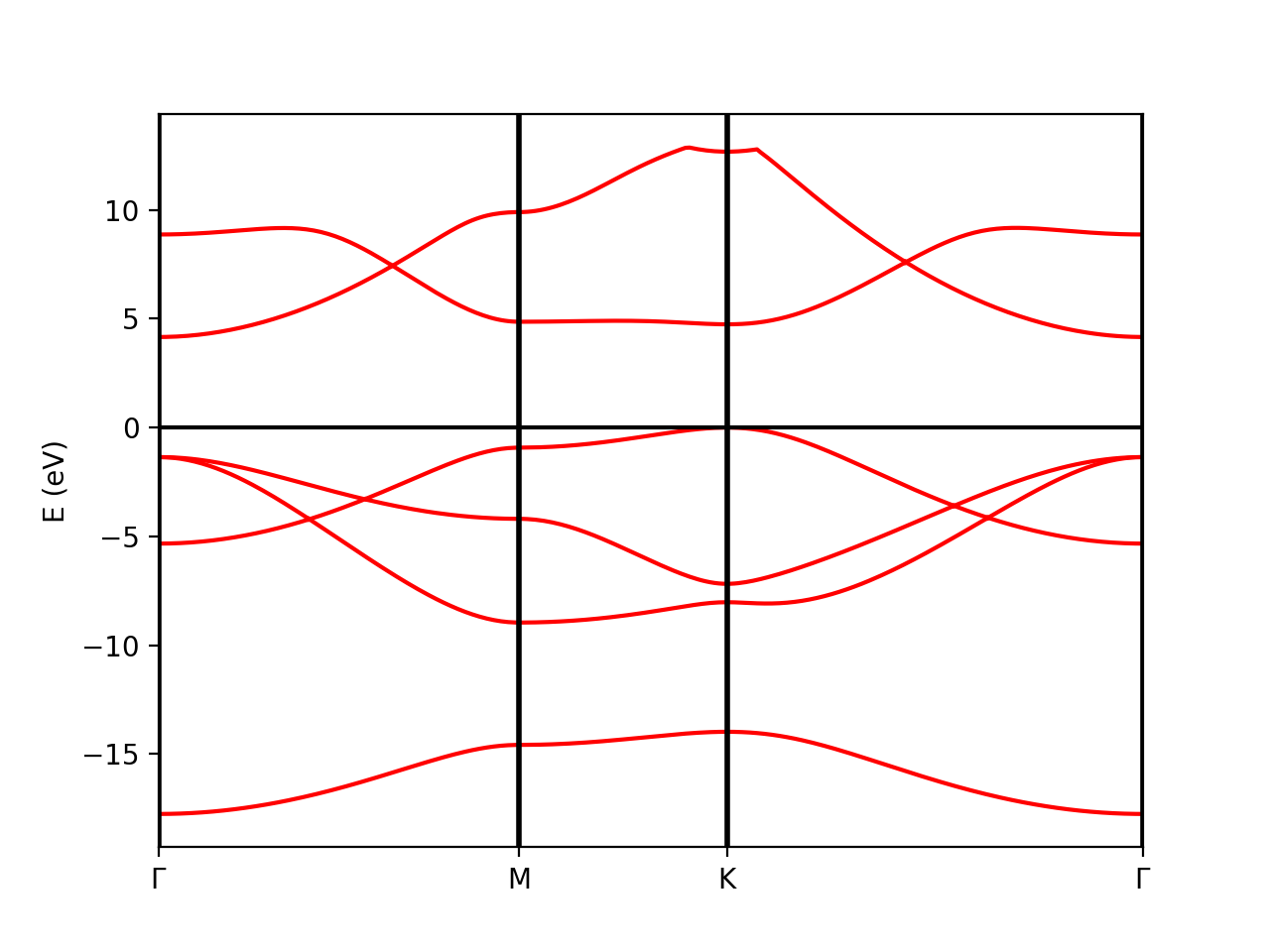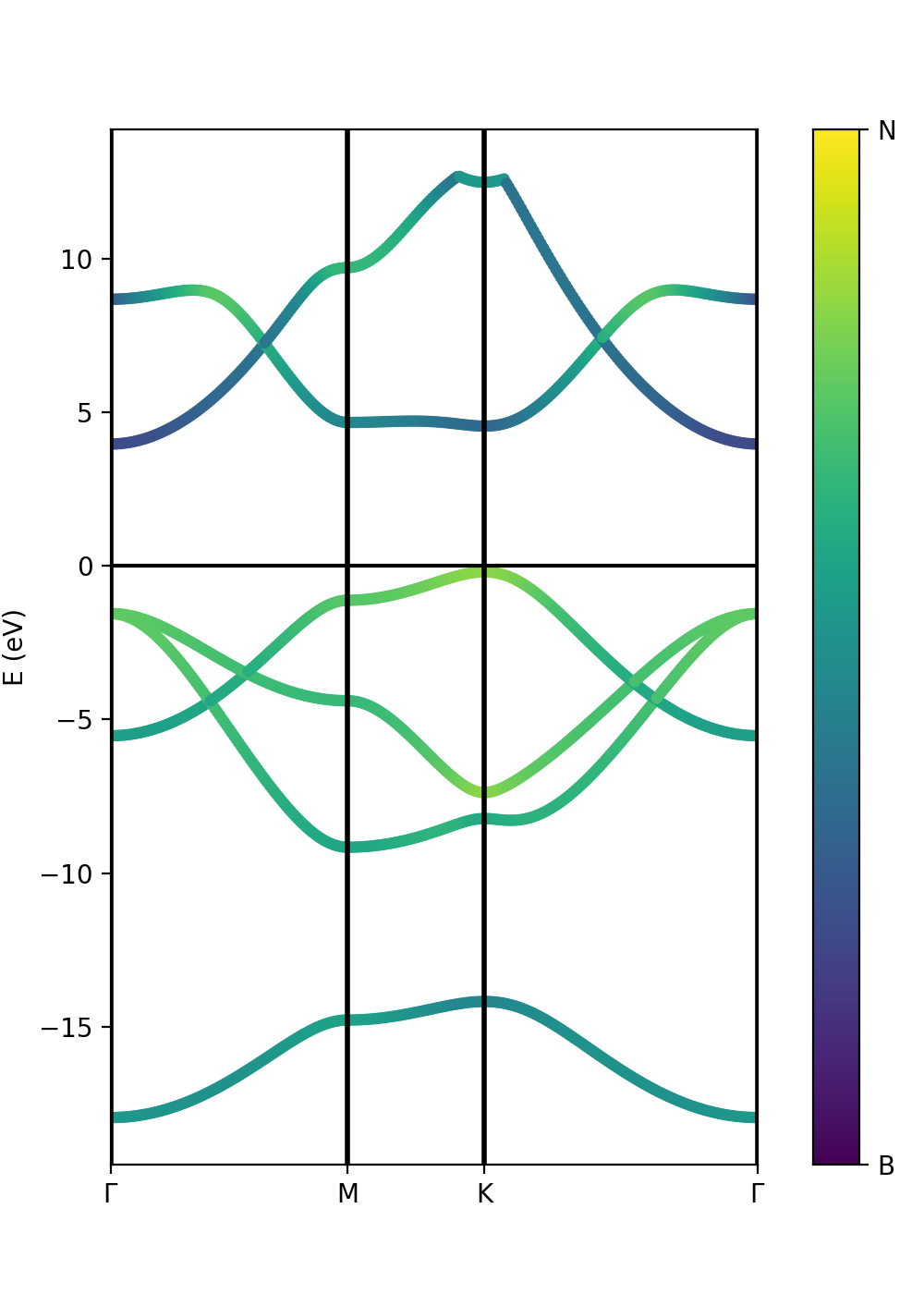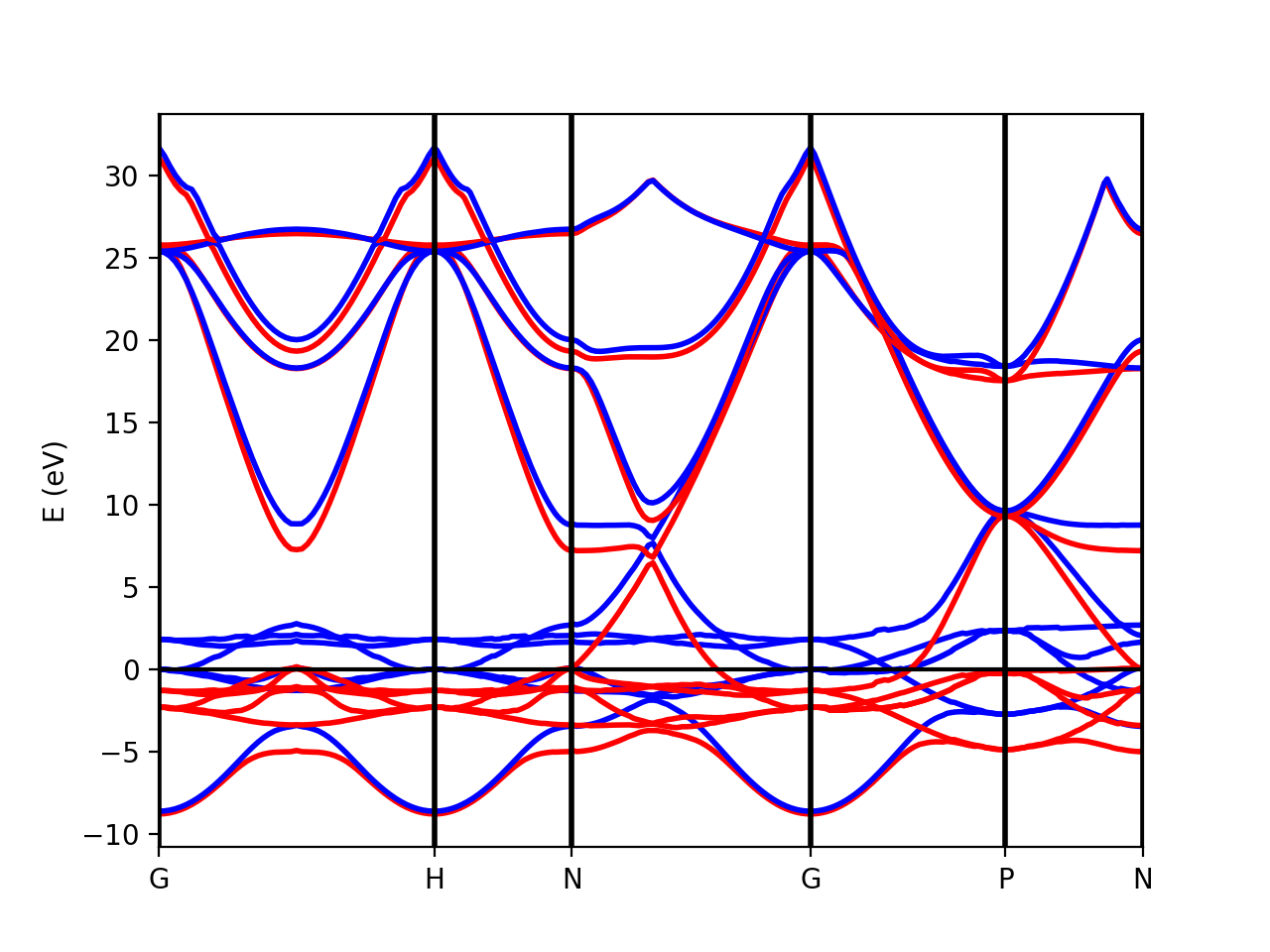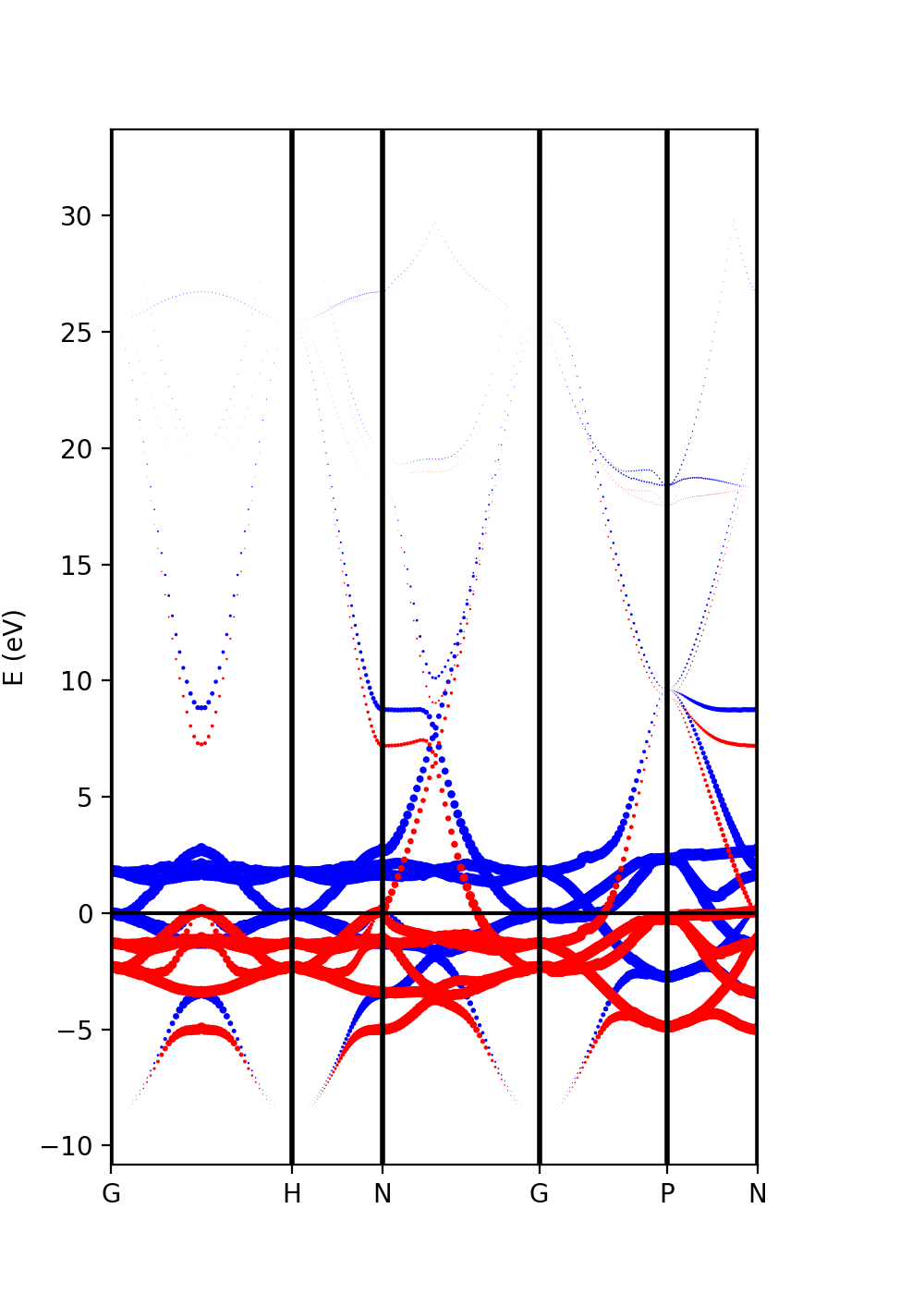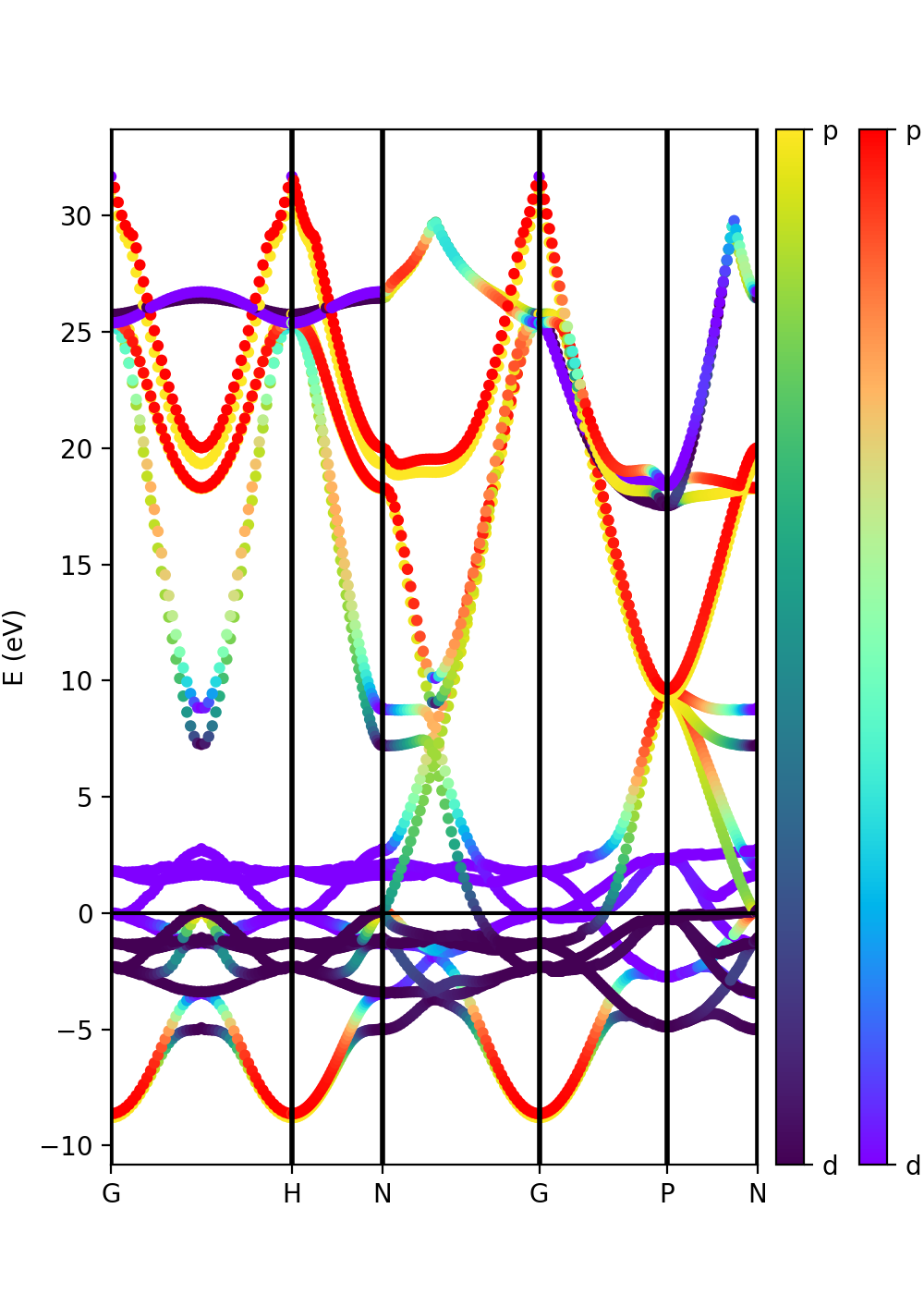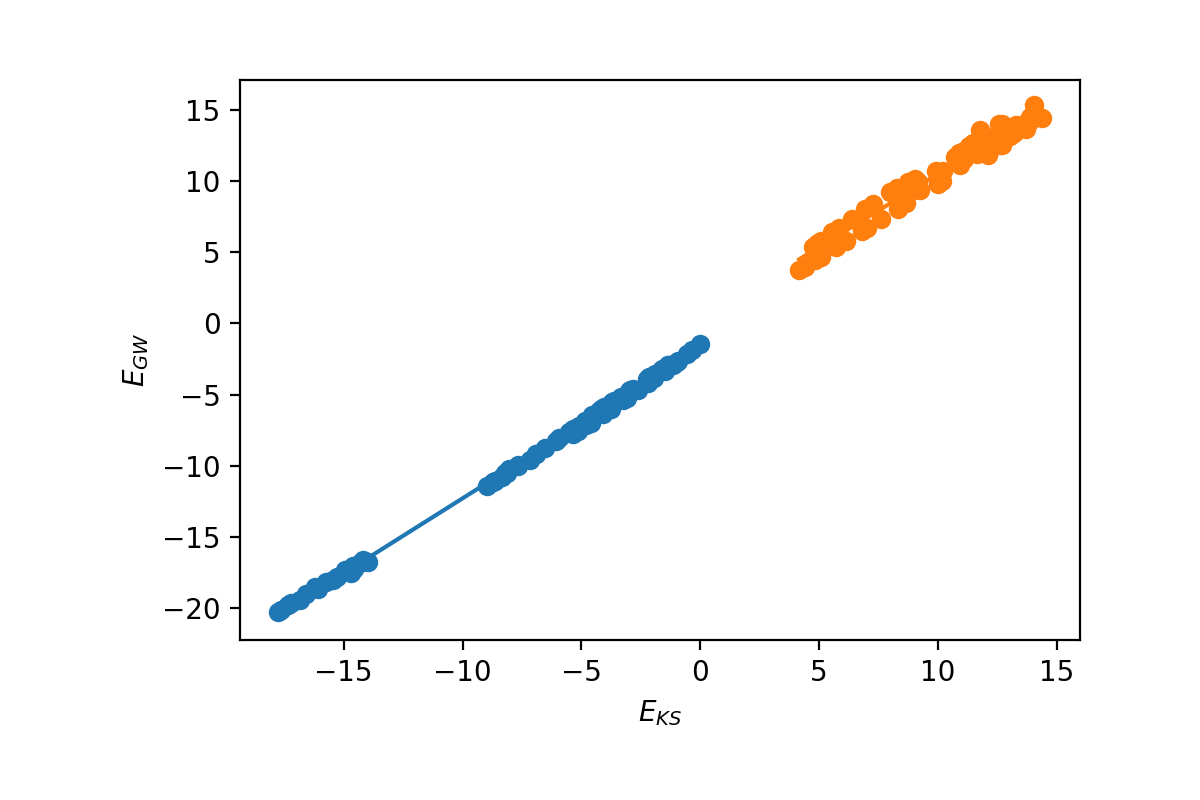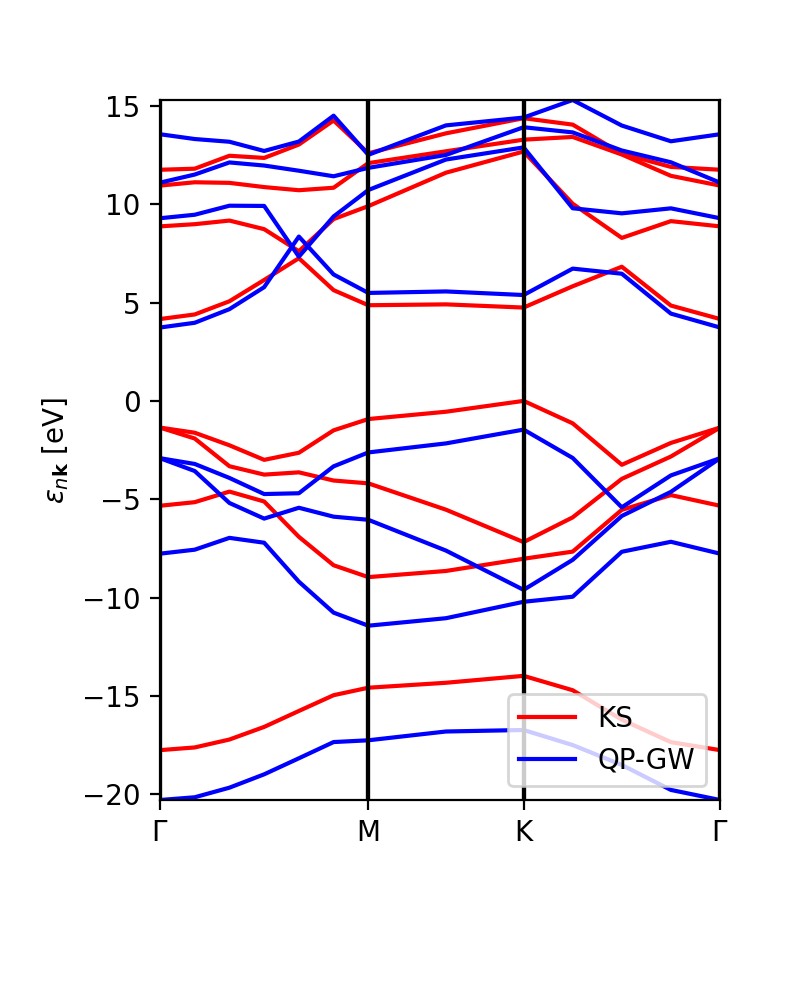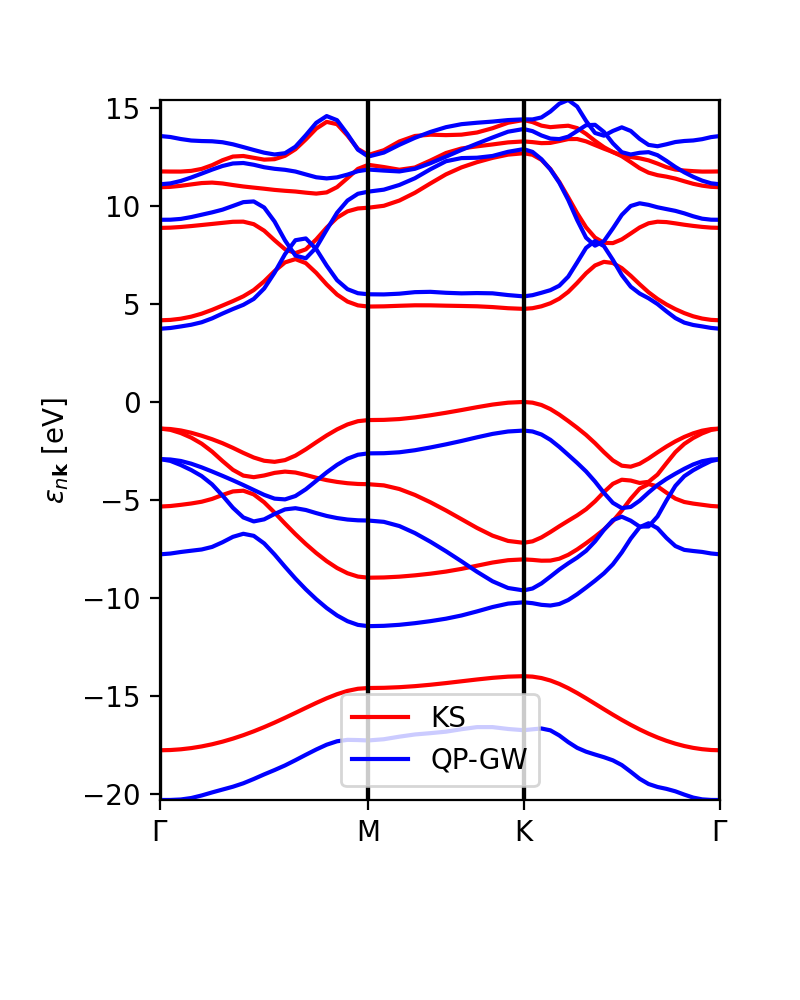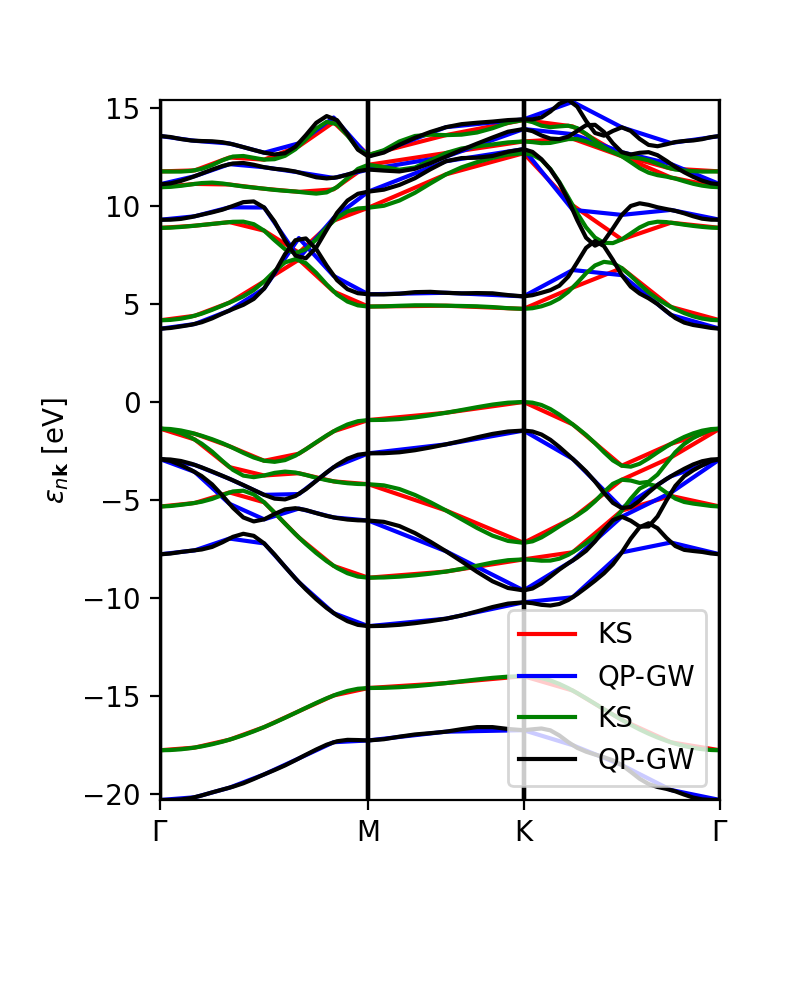Modena 2025 : Yambopy part 1: Difference between revisions
(Started first yambopy tutorial page for Modena school 2025) |
No edit summary |
||
| Line 2: | Line 2: | ||
The first section of this tutorial will show you how to visualise wave-function and band-structure related information, such as atomic, orbital and spin projections, following a DFT Quantum Espresso calculation using the "qepy" submodule of Yambopy. In the second section, we will start using the "yambopy" submodule to read the Yambo binary databases in order access reciprocal space data, dipole matrix elements and the RPA response function. | The first section of this tutorial will show you how to visualise wave-function and band-structure related information, such as atomic, orbital and spin projections, following a DFT Quantum Espresso calculation using the "qepy" submodule of Yambopy. In the second section, we will start using the "yambopy" submodule to read the Yambo binary databases in order access reciprocal space data, dipole matrix elements and the RPA response function. | ||
In order to run both parts 1 and 2, you need to copy and extract the tar file named 'yambopy_tutorial_Modena_2025.tar.gz' that you find in the WORK directory: | In order to run both parts 1 and 2, you need to copy and extract the tar file named '''yambopy_tutorial_Modena_2025.tar.gz''' that you find in the '''WORK''' directory: | ||
cd $SCRATCH | cd $SCRATCH | ||
mkdir YAMBOPY_TUTORIALS | mkdir YAMBOPY_TUTORIALS | ||
| Line 37: | Line 37: | ||
It is worth to note that the path should coincide with the selected path for the QE band calculations. | It is worth to note that the path should coincide with the selected path for the QE band calculations. | ||
In order to show the plot we call the '''plot_eigen''' method of the '''PwXML''' class: | In order to show the plot we can call the '''plot_eigen''' method of the '''PwXML''' class: | ||
xml.plot_eigen(path_kpoints) | xml.plot_eigen(path_kpoints) | ||
This function will automatically plot the bands as | This function will automatically plot the bands. Alternatively, we can use the function '''plot_eigen_ax''': | ||
fig = plt.figure() | |||
ax = fig.add_subplot(1,1,1) | |||
xml.plot_eigen_ax(ax,path_kpoints) | |||
This functions requires as input a matplotlib '''figure''' object with given axes. We can produce a figure by running the script: | |||
python plot-qe-bands.py | python plot-qe-bands.py | ||
[[File:Bands BN 1.png| 400 px | center |Band structure of BN calculated at the level of DFT-LDA]] | [[File:Bands BN 1.png| 400 px | center |Band structure of BN calculated at the level of DFT-LDA]] | ||
===Plot atomic orbital projected Band structure=== | ===Plot atomic orbital projected Band structure=== | ||
In addition to the band structure, useful information regarding the atomic orbital nature of the electronic wave functions can be displayed using the class '''ProjwfcXML'''. | In addition to the band structure, useful information regarding the atomic orbital nature of the electronic wave functions can be displayed using the class '''ProjwfcXML'''. | ||
In order to make quantum espresso calculate the relevant data, we need to use the QE executable '''projwfc.x''', which will create the file '''atomic_proj.xml'''. This executable projects the Kohn-Sham wavefunctions onto orthogonalized atomic orbitals, among others functionalities. The orbital indexing and ordering are explained in the input documentation of the projwfc.x function which you are invited to check (https://www.quantum-espresso.org/Doc/INPUT_PROJWFC.html#idm94). | In order to make quantum espresso calculate the relevant data, we need to use the QE executable '''projwfc.x''', which will create the file '''atomic_proj.xml'''. This executable projects the Kohn-Sham wavefunctions onto orthogonalized atomic orbitals, among others functionalities. The orbital indexing and ordering are explained in the input documentation of the projwfc.x function which you are invited to check (https://www.quantum-espresso.org/Doc/INPUT_PROJWFC.html#idm94). In this example, '''projwfc.x''' has been already run. | ||
As in the class '''PwXML''', we then define the path_kpoints and also the selected atomic orbitals to project our bands. We have chosen to represent the projection weight onto the nitrogen (1) and boron (2) orbitals, which can be obtained with | |||
# Automatic selection of the states | # Automatic selection of the states | ||
| Line 92: | Line 93: | ||
cb1.set_ticklabels(['B', 'N']) | cb1.set_ticklabels(['B', 'N']) | ||
Suppose now that we have run | Suppose now that we have run a G0W0 calculation (see part 2 of the Yambopy tutorial), and we want to represent the atomic weights on top of the quasiparticle band structure instead of the Kohn-Sham one. However, we do not have the same kpoint grid between the G0W0 calculation and the quantum espresso "band" calculation along a path. We can then extract the parameters for a scissor operator (this is done in part 2) and feed them to the '''ProjwfcXML''' class together with the number of valence bands. Try uncommenting the following lines in the tutorial script: | ||
# Add scissor operator to the bands from a G0W0 calculation | # Add scissor operator to the bands from a G0W0 calculation | ||
| Line 99: | Line 100: | ||
band.add_scissor(n_val,scissor) | band.add_scissor(n_val,scissor) | ||
Finally, we can also plot the band orbital character with size variation instead of a color scale. In this case we have to pass only the variable selected_orbitals (see | Finally, we can also plot the band orbital character with size variation instead of a color scale. In this case we have to pass only the variable selected_orbitals (see below). | ||
==Tutorial 2. Iron. Ferromagnetic metallic material== | ==Tutorial 2. Iron. Ferromagnetic metallic material== | ||
Let's move to a magnetic system: | |||
cd ../iron-metal | |||
In the case of spin-polarized calculations we can plot the spin up and down band structures. After completing a band structure calculation for iron with Quantum ESPRESSO, we can make the band plot by running the script: | |||
In | |||
python plot-qe-bands.py | python plot-qe-bands.py | ||
| Line 123: | Line 122: | ||
xml = PwXML(prefix='pw',path='bands/t0') | xml = PwXML(prefix='pw',path='bands/t0') | ||
xml.plot_eigen(path_kpoints) | #xml.plot_eigen(path_kpoints) | ||
fig = plt.figure() | |||
ax = fig.add_subplot(1,1,1) | |||
xml.plot_eigen_ax(ax,path_kpoints,lw=1.5) | |||
[[File:Figure 3-iron-bands.png| 600 px | center |Spin polarized band structure of iron calculated by DFT]] | [[File:Figure 3-iron-bands.png| 600 px | center |Spin polarized band structure of iron calculated by DFT]] | ||
| Line 130: | Line 132: | ||
Let us look first at the file '''plot-qe-orbitals-size'''. <br> | Let us look first at the file '''plot-qe-orbitals-size'''. <br> | ||
We can use the dot size as a function of the weight of the orbitals | |||
# Automatic selection of the states | # Automatic selection of the states | ||
s = band.get_states_helper(orbital_query=['s']) | s = band.get_states_helper(orbital_query=['s']) | ||
| Line 240: | Line 238: | ||
==Links== | ==Links== | ||
* Back to [[ | * Back to [[Modena 2025]] | ||
Revision as of 16:34, 18 May 2025
The first section of this tutorial will show you how to visualise wave-function and band-structure related information, such as atomic, orbital and spin projections, following a DFT Quantum Espresso calculation using the "qepy" submodule of Yambopy. In the second section, we will start using the "yambopy" submodule to read the Yambo binary databases in order access reciprocal space data, dipole matrix elements and the RPA response function.
In order to run both parts 1 and 2, you need to copy and extract the tar file named yambopy_tutorial_Modena_2025.tar.gz that you find in the WORK directory:
cd $SCRATCH mkdir YAMBOPY_TUTORIALS cd YAMBOPY_TUTORIALS rsync -avzP /leonardo_work/tra25_yambo/YAMBOPY_TUTORIALS/yambopy_tutorial_Modena_2025.tar.gz . tar -xvzf yambopy_tutorial_Modena_2025.tar.gz
Plot band structures from Quantum ESPRESSO
Tutorial 1. BN (semiconductor). Band structure
First enter in the folder
cd databases_qepy/bn-semiconductor
and have a look to the
vim plot-qe-bands.py
The qepy classes are useful both to execute Quantum Espresso and to analyze the results. Enter in the python environment, by typing python, then the full qepy library is imported by simply doing:
from qepy import *
Plot Band structure
The qepy class PwXML reads the data file generated by Quantum Espresso and post-processes the data. The class is instanced by doing:
xml = PwXML(prefix='bn', path='bands')
The variable prefix corresponds to the same variable of the QE input. The folder location is indicated by variable path. In order to plot the bands, we also define the k-points path (in crystal coordinates) using the function Path:
npoints = 50
path_kpoints = Path([ [[0.0, 0.0, 0.0],'$\Gamma$'],
[[0.5, 0.0, 0.0],'M'],
[[1./3,1./3,0.0],'K'],
[[0.0, 0.0, 0.0],'$\Gamma$']], [int(npoints*2),int(npoints),int(sqrt(5)*npoints)])
It is worth to note that the path should coincide with the selected path for the QE band calculations.
In order to show the plot we can call the plot_eigen method of the PwXML class:
xml.plot_eigen(path_kpoints)
This function will automatically plot the bands. Alternatively, we can use the function plot_eigen_ax:
fig = plt.figure() ax = fig.add_subplot(1,1,1) xml.plot_eigen_ax(ax,path_kpoints)
This functions requires as input a matplotlib figure object with given axes. We can produce a figure by running the script:
python plot-qe-bands.py
Plot atomic orbital projected Band structure
In addition to the band structure, useful information regarding the atomic orbital nature of the electronic wave functions can be displayed using the class ProjwfcXML. In order to make quantum espresso calculate the relevant data, we need to use the QE executable projwfc.x, which will create the file atomic_proj.xml. This executable projects the Kohn-Sham wavefunctions onto orthogonalized atomic orbitals, among others functionalities. The orbital indexing and ordering are explained in the input documentation of the projwfc.x function which you are invited to check (https://www.quantum-espresso.org/Doc/INPUT_PROJWFC.html#idm94). In this example, projwfc.x has been already run.
As in the class PwXML, we then define the path_kpoints and also the selected atomic orbitals to project our bands. We have chosen to represent the projection weight onto the nitrogen (1) and boron (2) orbitals, which can be obtained with
# Automatic selection of the states atom_1 = band.get_states_helper(atom_query=['N']) atom_2 = band.get_states_helper(atom_query=['B'])
The full list of orbitals is written in the file bands/prowfc.log. By inspecting it, you may also construct custom lists of states.
We have also defined the figure box
import matplotlib.pyplot as plt fig = plt.figure(figsize=(5,7)) ax = fig.add_axes( [ 0.12, 0.10, 0.70, 0.80 ])
The class ProjwfcXML then runs as in this example:
band = ProjwfcXML(prefix='bn',path='bands',qe_version='7.0') band.plot_eigen(ax,path_kpoints=path_kpoints,cmap='viridis',selected_orbitals=atom_1,selected_orbitals_2=atom_2)
We can run now the file:
python plot-qe-orbitals.py
We have chosen the colormap 'viridis' (variable cmap). You see that the colormap goes from maximum selected_orbitals content (in this case nitrogen) to the maximum selected_orbitals_2 content (in this case boron). The colormap can be represented in many ways and qepy does not include a particular function for this. An example is:
import matplotlib as mpl
cmap=plt.get_cmap('viridis')
bx = fig.add_axes( [ 0.88, 0.10, 0.05, 0.80 ])
norm = mpl.colors.Normalize(vmin=0.,vmax=1.)
cb1 = mpl.colorbar.ColorbarBase(bx, cmap=cmap, norm=norm,orientation='vertical',ticks=[0,1])
cb1.set_ticklabels(['B', 'N'])
Suppose now that we have run a G0W0 calculation (see part 2 of the Yambopy tutorial), and we want to represent the atomic weights on top of the quasiparticle band structure instead of the Kohn-Sham one. However, we do not have the same kpoint grid between the G0W0 calculation and the quantum espresso "band" calculation along a path. We can then extract the parameters for a scissor operator (this is done in part 2) and feed them to the ProjwfcXML class together with the number of valence bands. Try uncommenting the following lines in the tutorial script:
# Add scissor operator to the bands from a G0W0 calculation scissor= [1.8985195950522469, 1.0265240811345133, 1.051588659878575] n_val = 4 band.add_scissor(n_val,scissor)
Finally, we can also plot the band orbital character with size variation instead of a color scale. In this case we have to pass only the variable selected_orbitals (see below).
Tutorial 2. Iron. Ferromagnetic metallic material
Let's move to a magnetic system:
cd ../iron-metal
In the case of spin-polarized calculations we can plot the spin up and down band structures. After completing a band structure calculation for iron with Quantum ESPRESSO, we can make the band plot by running the script:
python plot-qe-bands.py
The class PwXML automatically detects the spin polarized case (nspin=2 in the QE input file). The spin up channel is displayed with red and the spin down channel with blue. In the case of iron we have selected this k-point path:
npoints = 50
path_kpoints = Path([ [[0.0, 0.0, 0.0 ],'G'],
[[0.0, 0.0, 1.0 ],'H'],
[[1./2,0.0,1./2.],'N'],
[[0.0, 0.0, 0.0 ],'G'],
[[1./2, 1./2, 1./2 ],'P'],
[[1./2,0.0,1./2. ],'N']], [npoints,npoints,npoints,npoints,npoints])
xml = PwXML(prefix='pw',path='bands/t0') #xml.plot_eigen(path_kpoints) fig = plt.figure() ax = fig.add_subplot(1,1,1) xml.plot_eigen_ax(ax,path_kpoints,lw=1.5)
The analysis of the projected atomic orbitals is also implemented. In this case the results are more cumbersome because the projection is separated in spin up and down channels.
Let us look first at the file plot-qe-orbitals-size.
We can use the dot size as a function of the weight of the orbitals
# Automatic selection of the states s = band.get_states_helper(orbital_query=['s']) p = band.get_states_helper(orbital_query=['p']) d = band.get_states_helper(orbital_query=['d'])
and the plots are done with
band = ProjwfcXML(prefix='pw',path='bands/t0',qe_version='7.0') band.plot_eigen(ax,path_kpoints=path_kpoints,selected_orbitals=s,color='pink',color_2='black') band.plot_eigen(ax,path_kpoints=path_kpoints,selected_orbitals=p,color='green',color_2='orange') band.plot_eigen(ax,path_kpoints=path_kpoints,selected_orbitals=d,color='red',color_2='blue')
As an example, we can select just the d orbitals by commenting the first two plots and then running the file:
plot-qe-orbitals-size.py
From the plot is clear that d orbitals are mainly localized around the Fermi energy. The plot above is in red and blue, while the default choice in your script should be pink and black. You can experiment with the colors and other matplotlib plot options and also plot the other orbital types.
Another option is to plot the orbital composition as a colormap running the file:
plot-qe-orbitals-colormap.py
Here we have added the p and d orbitals in the analysis:
p = band.get_states_helper(orbital_query=['p']) d = band.get_states_helper(orbital_query=['d']) band = ProjwfcXML(prefix='pw',path='bands/t0',qe_version='7.0') band.plot_eigen(ax,path_kpoints=path_kpoints,cmap='viridis',cmap2='rainbow',selected_orbitals=p,selected_orbitals_2=d)
The colormap bar is added in the same way as in Tutorial 1 (see script), but this time we have a different colormap for each spin polarisation.
Tutorial 3: GW bands
Yambopy can be used either to run Yambo and QE calculations, or to analyse the results of QE and Yambo by dealing with their generated databases. This is done with a variety of classes included in the qepy (for QE) or yambopy (for Yambo) modules. In the case of Yambo GW quasi-particle calculations, we can use the yambopy class YamboQPDB to read the database produced by the simulation. Enter in the folder
cd ../gw-bands
We can use this to find the scissor operator, plot the GW bands and to interpolate the GW bands on a smoother k-path. The example runs by typing:
python plot-qp.py
See below for an explanation of the tutorial. As usual, we can import the qepy and yambopy libraries:
from qepy import * from yambopy import * import matplotlib.pyplot as plt
We define the k-points path.
npoints = 10
path = Path([ [[ 0.0, 0.0, 0.0],'$\Gamma$'],
[[ 0.5, 0.0, 0.0],'M'],
[[1./3.,1./3., 0.0],'K'],
[[ 0.0, 0.0, 0.0],'$\Gamma$']], [int(npoints*2),int(npoints),int(sqrt(5)*npoints)] )
Importantly, the number of points is a free choice. We can increase the variable npoints as we wish, it just means that the interpolation step will take more time. In order to analyse GW results we need to have the file related to the basic data of our Yambo calculation (SAVE/ns.db1) and the netcdf file with the quasi-particle results (ndb.QP). We load the data calling the respective classes:
# Read Lattice information from SAVE lat = YamboSaveDB.from_db_file(folder='SAVE',filename='ns.db1') # Read QP database ydb = YamboQPDB.from_db(filename='ndb.QP',folder='qp-gw')
(in the yambopy module, each class is specialised to read a specific Yambo database)
The first option is to plot the energies and calculate the ideal Kohn-Sham to GW scissor operator. We need to select the index of the top valence band:
n_top_vb = 4 ydb.plot_scissor_ax(ax,n_top_vb)
Yambopy displays the fitting and also the data of the slope of each fitting. Notice that this is also a test if the GW calculations are running well. If the dependence is not linear you should double-check your results!
In this case the slope is:
valence bands: slope: 1.0515886598785766 conduction bands: slope: 1.026524081134514 scissor list (shift,c,v) [eV,adim,adim]: [1.8985204833551723, 1.026524081134514, 1.0515886598785766]
In addition to the scissor operator, we can plot the GW (and DFT) band structure along the path. The first choice would be to plot the actual GW calculations, without interpolation, to check that the results are meaningful (or not). This plot is independent of the number of k-points (npoints) that we want to put in the interpolation. The class YamboQPDB finds the calculated points that belong to the path and plots them. Be aware that if we use coarse grids the class would not find any point and the function will not work.
ks_bs_0, qp_bs_0 = ydb.get_bs_path(lat,path) ks_bs_0.plot_ax(ax,legend=True,c_bands='r',label='KS') qp_bs_0.plot_ax(ax,legend=True,c_bands='b',label='QP-GW')
The interpolation of the DFT and GW band structures looks similar:
ks_bs, qp_bs = ydb.interpolate(lat,path,what='QP+KS',lpratio=20) ks_bs.plot_ax(ax,legend=True,c_bands='r',label='KS') qp_bs.plot_ax(ax,legend=True,c_bands='b',label='QP-GW')
The lpratio can be increased if the interpolation does not work as well as intended. The SKW interpolation scheme is the same on implemented in abipy.
Finally, we can compare the calculated GW eigenvalues with the interpolation.
Links
- Back to Modena 2025
